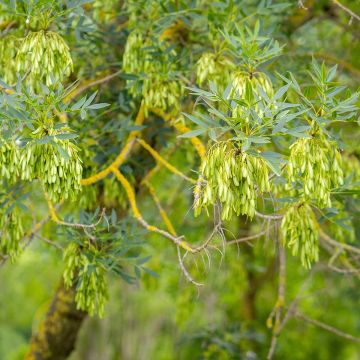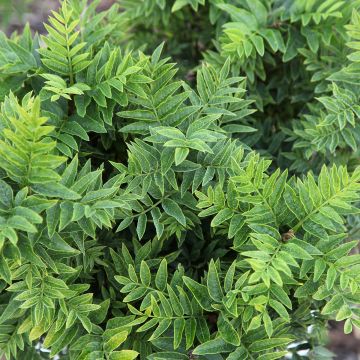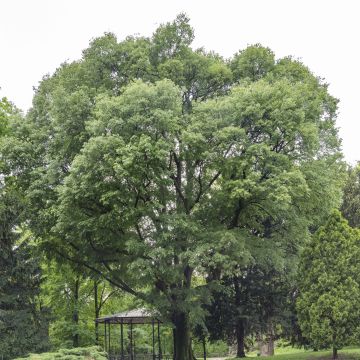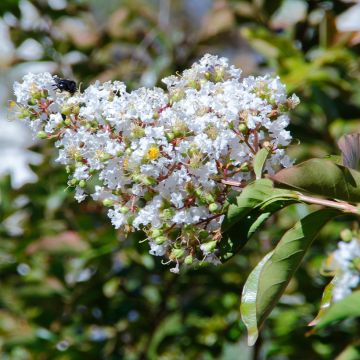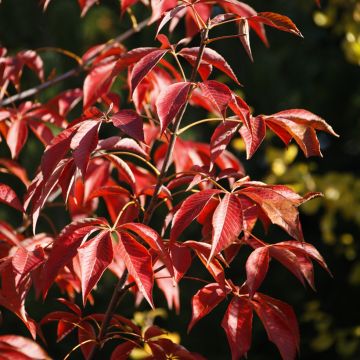

Fraxinus pennsylvanica Crispa - Green ash
Fraxinus pennsylvanica Crispa - Green ash
Fraxinus pennsylvanica Crispa
Green ash
This item cannot be shipped to the selected country
Oversize package delivery charge from €6.90
More information
Schedule delivery date,
and select date in basket
This plant carries a 24 months recovery warranty
More information
We guarantee the quality of our plants for a full growing cycle, and will replace at our expense any plant that fails to recover under normal climatic and planting conditions.
Oversize package: home delivery by special carrier from €6.90 per order..
Express home delivery from €8.90.
Does this plant fit my garden?
Set up your Plantfit profile →
Description
Fraxinus pennsylvanica 'Crispa' is a Pennsylvania Ash tree with a "ball" shape and crinkled foliage. It is a variety grafted on a trunk, with a crown that has a beautiful spherical or oval shape, dense and regular. This elegant deciduous tree displays beautiful colours in autumn. Resistant to air pollution, it adapts well to urban conditions.
Fraxinus pennsylvanica, also known as the red ash or green ash, is a tree in the olive family, just like the olive tree. It is mainly found in North America, with a wide distribution area ranging from the Atlantic coast to Colorado, Alberta, and Montana in the west. Generally, it reaches a height of 12 to 25 metres and its trunk does not exceed 60 cm in diameter. In autumn, its foliage turns a beautiful lemon yellow, which is particularly attractive. Highly resistant to pollution and diseases, this species is often used as a street tree.
Fraxinus pennsylvanica 'Crispa' was introduced into the horticultural trade by Feliks Rożyński from the Zamoyski family nurseries in Podzamcze (Poland) in 1904. It has a straight trunk, the rootstock, whose height can vary. Its regular crown can reach between 3 and 6 metres in all directions. It can be shaped by pruning to achieve a more or less round or oval shape. The total height of the tree may vary depending on the height of the rootstock and the crown. On average, a specimen will reach a height of 5.50 to 6.50 metres with a crown of 3.50 metres in diameter. The foliage is deciduous and has an unusual appearance. It consists of leaves divided into thick leaflets, slightly curled with wavy margins. The leaves are dark green until late summer, then they turn yellow and rusty before falling in autumn.
The Pennsylvania Ash 'Crispa' is a tree with moderate growth that can be used as a solitary specimen on a lawn, near a terrace for shade, or to frame a gate. In urban settings, it is planted in rows along streets. While it is robust, it is sensitive to stagnant water and hot, dry conditions. To enhance its appearance, spring bulbs can be planted at its base, including daffodils and snowdrops. Fans of "ball" trees will also appreciate Acer platanoides 'Globosum', the umbrella acacia (Robinia pseudoacacia 'Umbraculifera'), Platanus acerifolia 'Alphen's Globe', and Ginkgo biloba 'Mariken'.
Report an error about the product description
Plant habit
Foliage
Safety measures
Botanical data
Fraxinus
pennsylvanica
Crispa
Oleaceae
Green ash
Cultivar or hybrid
atteinterespiratoire
Cette plante peut entraîner des symptômes allergiques.
Evitez de la planter si vous ou vos proches souffrez de rhinite saisonnière ("rhume des foins").
Davantage d'informations sur https://plantes-risque.info
Other Fraxinus - Ash tree
Planting and care
Plant your Fraxinus pennsylvanica 'Crispa' in autumn or spring, choose an open location in full sun, where the soil is deep, and keep in mind the space it will take up in the long term. If necessary, create a drainage pit with rocks if your soil is waterlogged. If your soil is poor, a generous addition of leaf compost will be beneficial. Maintain regular watering during the summer following planting and ensure it is protected from prolonged droughts for another year, mulching can help retain moisture at the base and space out watering. This tree requires consistently moist soil, at least at depth. It is perfectly frost resistant. Prune to balance the shape of the tree by opening up the centre of the crown and shortening overly long branches.
Planting period
Intended location
Care
This item has not been reviewed yet - be the first to leave a review about it.
Striking foliage shrubs
Haven't found what you were looking for?
Hardiness is the lowest winter temperature a plant can endure without suffering serious damage or even dying. However, hardiness is affected by location (a sheltered area, such as a patio), protection (winter cover) and soil type (hardiness is improved by well-drained soil).

Photo Sharing Terms & Conditions
In order to encourage gardeners to interact and share their experiences, Promesse de fleurs offers various media enabling content to be uploaded onto its Site - in particular via the ‘Photo sharing’ module.
The User agrees to refrain from:
- Posting any content that is illegal, prejudicial, insulting, racist, inciteful to hatred, revisionist, contrary to public decency, that infringes on privacy or on the privacy rights of third parties, in particular the publicity rights of persons and goods, intellectual property rights, or the right to privacy.
- Submitting content on behalf of a third party;
- Impersonate the identity of a third party and/or publish any personal information about a third party;
In general, the User undertakes to refrain from any unethical behaviour.
All Content (in particular text, comments, files, images, photos, videos, creative works, etc.), which may be subject to property or intellectual property rights, image or other private rights, shall remain the property of the User, subject to the limited rights granted by the terms of the licence granted by Promesse de fleurs as stated below. Users are at liberty to publish or not to publish such Content on the Site, notably via the ‘Photo Sharing’ facility, and accept that this Content shall be made public and freely accessible, notably on the Internet.
Users further acknowledge, undertake to have ,and guarantee that they hold all necessary rights and permissions to publish such material on the Site, in particular with regard to the legislation in force pertaining to any privacy, property, intellectual property, image, or contractual rights, or rights of any other nature. By publishing such Content on the Site, Users acknowledge accepting full liability as publishers of the Content within the meaning of the law, and grant Promesse de fleurs, free of charge, an inclusive, worldwide licence for the said Content for the entire duration of its publication, including all reproduction, representation, up/downloading, displaying, performing, transmission, and storage rights.
Users also grant permission for their name to be linked to the Content and accept that this link may not always be made available.
By engaging in posting material, Users consent to their Content becoming automatically accessible on the Internet, in particular on other sites and/or blogs and/or web pages of the Promesse de fleurs site, including in particular social pages and the Promesse de fleurs catalogue.
Users may secure the removal of entrusted content free of charge by issuing a simple request via our contact form.
The flowering period indicated on our website applies to countries and regions located in USDA zone 8 (France, the United Kingdom, Ireland, the Netherlands, etc.)
It will vary according to where you live:
- In zones 9 to 10 (Italy, Spain, Greece, etc.), flowering will occur about 2 to 4 weeks earlier.
- In zones 6 to 7 (Germany, Poland, Slovenia, and lower mountainous regions), flowering will be delayed by 2 to 3 weeks.
- In zone 5 (Central Europe, Scandinavia), blooming will be delayed by 3 to 5 weeks.
In temperate climates, pruning of spring-flowering shrubs (forsythia, spireas, etc.) should be done just after flowering.
Pruning of summer-flowering shrubs (Indian Lilac, Perovskia, etc.) can be done in winter or spring.
In cold regions as well as with frost-sensitive plants, avoid pruning too early when severe frosts may still occur.
The planting period indicated on our website applies to countries and regions located in USDA zone 8 (France, United Kingdom, Ireland, Netherlands).
It will vary according to where you live:
- In Mediterranean zones (Marseille, Madrid, Milan, etc.), autumn and winter are the best planting periods.
- In continental zones (Strasbourg, Munich, Vienna, etc.), delay planting by 2 to 3 weeks in spring and bring it forward by 2 to 4 weeks in autumn.
- In mountainous regions (the Alps, Pyrenees, Carpathians, etc.), it is best to plant in late spring (May-June) or late summer (August-September).
The harvesting period indicated on our website applies to countries and regions in USDA zone 8 (France, England, Ireland, the Netherlands).
In colder areas (Scandinavia, Poland, Austria...) fruit and vegetable harvests are likely to be delayed by 3-4 weeks.
In warmer areas (Italy, Spain, Greece, etc.), harvesting will probably take place earlier, depending on weather conditions.
The sowing periods indicated on our website apply to countries and regions within USDA Zone 8 (France, UK, Ireland, Netherlands).
In colder areas (Scandinavia, Poland, Austria...), delay any outdoor sowing by 3-4 weeks, or sow under glass.
In warmer climes (Italy, Spain, Greece, etc.), bring outdoor sowing forward by a few weeks.

































